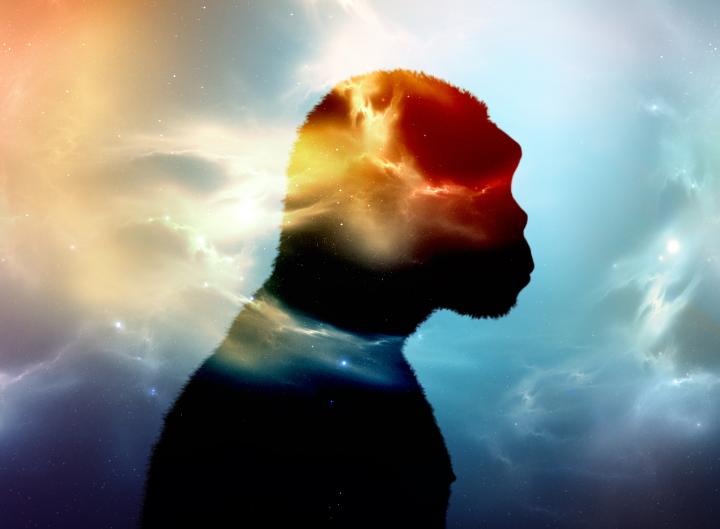
In saliva, scientists have found hints that a “ghost” species of archaic human may have contributed genetic material to ancestors of people living in Sub-Saharan Africa today. The finding comes from research that examined the evolutionary history of MUC7, a gene that codes for an important salivary protein. [Bob Wilder/University at Buffalo]
Once again, genomic analysis has revealed evidence of the archaic human within. This time, it’s evidence of a “ghost” species of hominin, one that is making its presence known through a salivary protein—or rather, a gene that codes for an unusual version of this protein, which is known as MUC7.
A ghost species of hominin is an ancient human that makes itself known not through anything so tangible as fossils, but rather through genetic features that are passed down generation by generation. Sometimes these features are unusually conspicuous, unlikely to be part of the usually gradual drift of evolutionary change. Large, sudden changes in the DNA record are taken as hints that something sudden happened in the environment—a shift in climate, the arrival of a new pathogen, or something else—such as a tryst between different species.
This last possibility appears to account for a glitch in the evolutionary record of the MUC7 protein, which helps give spit its slimy consistency and binds to microbes, potentially helping to rid the body of disease-causing bacteria. When scientists based at the University at Buffalo examined the MUC7 gene in more than 2500 modern human genomes, they uncovered a surprise: A group of genomes from Sub-Saharan Africa had a version of the gene that was wildly different from versions found in other modern humans.
The Sub-Saharan variant was so distinctive that Neanderthal and Denisovan MUC7 genes matched more closely with those of other modern humans than the Sub-Saharan outlier did.
“Based on our analysis, the most plausible explanation for this extreme variation is archaic introgression—the introduction of genetic material from a 'ghost' species of ancient hominins,” said Omer Gokcumen, Ph.D., an assistant professor of biological sciences in the University at Buffalo College of Arts and Sciences. “This unknown human relative could be a species that has been discovered, such as a subspecies of Homo erectus, or an undiscovered hominin.”
Given the rate that genes mutate during the course of evolution, the team calculated that the ancestors of people who carry the Sub-Saharan MUC7 variant interbred with another ancient human species as recently as 150,000 years ago, after the two species' evolutionary path diverged from each other some 1.5 to 2 million years ago.
Details of the investigation appeared July 21 in the journal Molecular Biology and Evolution, in an article entitled “Archaic Hominin Introgression in Africa Contributes to Functional Salivary MUC7 Genetic Variation.” This article describes how the University at Buffalo scientists focused on the MUC7 gene’s copy number variable subexonic repeats (PTS-repeats), genetic features that in this case affect the size and glycosylation potential of the protein.
“Here, we found that PTS-repeat copy number variation has evolved recurrently in the human lineage, thereby generating multiple haplotypic backgrounds carrying 5 or 6 PTS-repeat copy number alleles,” wrote the article’s authors. “Contrary to previous studies, we found no associations between the copy number of PTS-repeat copy number and protection against asthma. Instead, we revealed a significant association of MUC7 haplotypic variation with the composition of the oral microbiome.”
In some people, the gene that codes for MUC7 holds six copies of genetic instructions that direct the body to build parts of the corresponding protein. In other people, the gene harbors only five sets of these instructions (known as tandem repeats).
Prior studies by other researchers found that the five-copy version of the gene protected against asthma, but the University at Buffalo scientists did not see this association when they ran a more detailed analysis.
The new study did conclude, however, that MUC7 appears to influence the makeup of the oral microbiome. The evidence for this came from an analysis of biological samples from 130 people, which found that different versions of the MUC7 gene were strongly associated with different oral microbiome compositions.
“From what we know of MUC7, it makes sense that people with different versions of the MUC7 gene could have different oral microbiomes,” noted Stefan Ruhl, D.D.S., Ph.D., a professor of oral biology in UB's School of Dental Medicine. “The MUC7 protein is thought to enhance the ability of saliva to bind to microbes, an important task that may help prevent disease by clearing unwanted bacteria or other pathogens from the mouth.”
Past studies have concluded that the forebears of modern humans in Asia and Europe interbred with other early hominin species, including Neanderthals and Denisovans. The new research is among more recent genetic analyses indicating that ancient Africans also had trysts with other early hominins. “Our results,” the authors of the current study concluded, “contribute to the emerging notion that functional variation introgressed from an African hominin into modern humans and has been maintained among contemporary African populations.”
“It seems that interbreeding between different early hominin species is not the exception—it's the norm,” emphasized Dr. Gokcumen.
More generally, the team indicated that its study exemplifies how combined locus-specific and genome-wide approaches can shed light onto the evolutionary history and functional implications of complex, recurrent structural variation: “Given that sub-exonic PTS repeat variation in other mucins, similar to that occurring in MUC7, may have critical roles for disease susceptibility and evolutionary innovations, we anticipate that our work will serve as a model to study other yet-to-be-discovered recurrent variants in similarly complex regions of the genome.”







